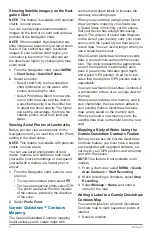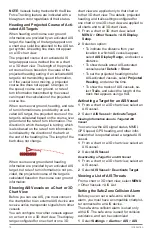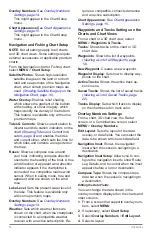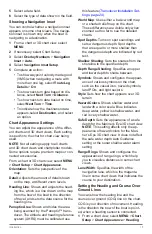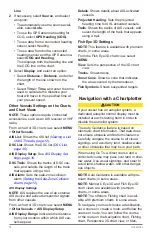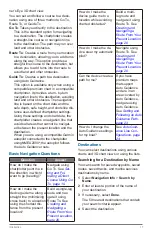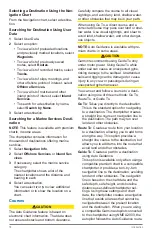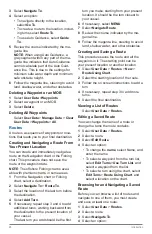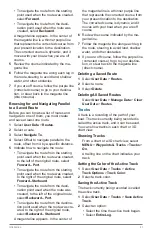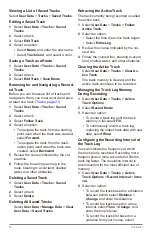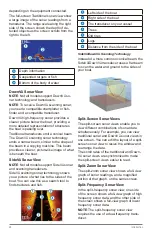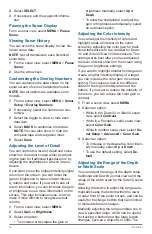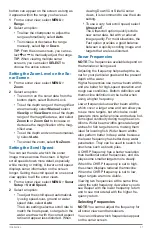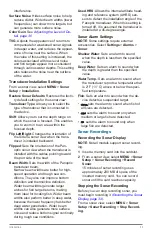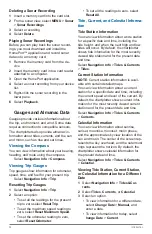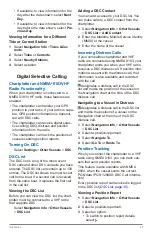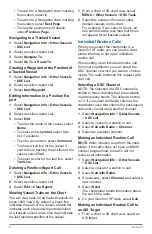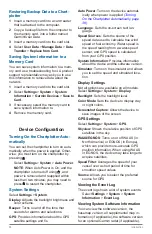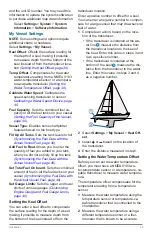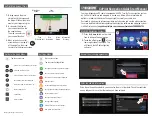
24
Introduction
ance line to be placed. The Auto Guidance
line may move if you change this setting
while navigating. The available values for
the Shoreline Distance setting are relative,
not absolute. To ensure the Auto Guidance
line is placed the appropriate distance from
shore, you can assess the placement of
the Auto Guidance line using one or more
familiar destinations that require navigation
through a narrow waterway.
1
Dock your vessel or drop the anchor.
2
Select
Settings
>
Navigation
>
Auto
Guidance
>
Shoreline Distance
>
Nor-
mal
.
3
Select a destination that you have navi-
gated to previously.
4
Select
Navigate To
>
Guide To
.
5
Review the placement of the Auto Guid-
ance line, and determine whether the line
safely avoids known obstacles and the
turns enable efficient travel.
6
Select an option:
•
If the placement of the Auto Guidance
line is satisfactory, select
MENU
>
Stop
Navigation
, and proceed to step10.
•
If the Auto Guidance line is too close
to known obstacles, select
Settings
>
Navigation
>
Auto Guidance
>
Shore-
line Distance
>
Far
.
•
If the turns in the Auto Guidance line
are too wide, select
Settings
>
Navi-
gation
>
Auto Guidance
>
Shoreline
Distance
>
Near
.
7
If you selected
Near
or
Far
in step 6,
review the placement of the Auto Guid-
ance line, and determine whether the line
safely avoids known obstacles and the
turns enable efficient travel.
Auto Guidance maintains a wide clear-
ance from obstacles in open water, even
if you set the Shoreline Distance set-
ting to Near or Nearest. As a result, the
chartplotter may not reposition the Auto
Guidance line, unless the destination
selected requires navigation through a
narrow waterway.
8
Select an option:
•
If the placement of the Auto Guidance
line is satisfactory, select
MENU
>
Stop
Navigation
, and proceed to step10.
•
If the Auto Guidance line is too close
to known obstacles, select
Settings
>
Navigation
>
Auto Guidance
>
Shore-
line Distance
>
Farthest
.
•
If the turns in the Auto Guidance line
are too wide, select
Settings
>
Navi-
gation
>
Auto Guidance
>
Shoreline
Distance
>
Nearest
.
9
If you selected Nearest or Farthest in
step 8, review the placement of the Auto
Guidance line, and determine whether the
line safely avoids known obstacles and
the turns enable efficient travel.
Auto Guidance maintains a wide clear-
ance from obstacles in open water, even
if you set the Shoreline Distance set-
ting to Near or Nearest. As a result, the
chartplotter may not reposition the Auto
Guidance line, unless the destination
selected requires navigation through a
narrow waterway.
10
Repeat steps 3 through 9 at least once
more, using a different destination each
time, until you are familiar with the func-
tionality of the Shoreline Distance setting.
Auto Guidance Line Configurations
CAUTION
The Safe Depth and Safe Height settings
influence how the chartplotter calculates an
Auto Guidance line. If an area has an un-
known water depth or an unknown obstacle
height, the Auto Guidance line is not calculat-
ed in that area. If an area at the beginning or
the end of an Auto Guidance line is shallower
than the safe water depth or lower than the
safe obstacle height, the Auto Guidance line
is not calculated in that area. On the chart,
the course through those areas appears as
a gray line. When your boat enters one of
those areas, a warning message appears.
NOTE
: Auto Guidance is available with pre-
mium charts, in some areas.
You can set the parameters the chartplotter
uses when calculating an Auto Guidance
line.
Safe Depth
: Sets the minimum depth (chart
depth datum) the chartplotter uses when
calculating an Auto Guidance line.
NOTE
: The minimum safe depth for the
premium charts is 3 feet. If you enter a
Safe Depth value of less than 3 feet, the
charts only use depths of 3 feet for Auto
Guidance route calculations.

